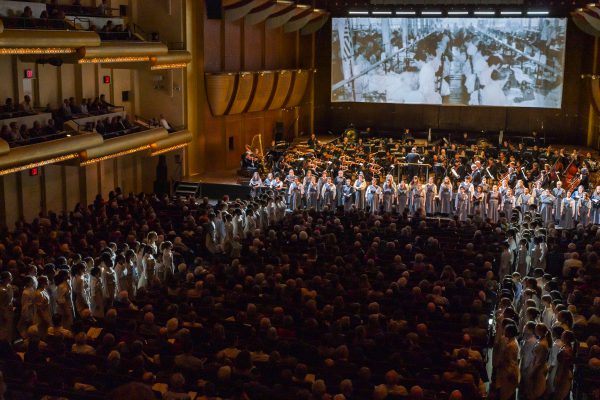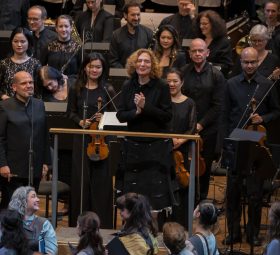Wolfe’s Philharmonic “Fire” premiere long on drama, short on meaning

New York Philharmonic and choirs, led by conductor Jaap Van Zweden, in the world premiere of Julia Wolfe’s “Fire in my mouth” Thursday at David Geffen Hall. Photo: Chris Lee/New York Philharmonic
There was no ignoring the “relevant” in the room at David Geffen Hall Thursday night.
Outside, a national political stalemate over immigration dragged on. Inside, the New York Philharmonic and conductor Jaap van Zweden gave the world premiere of an ambitious new work for large orchestra, women’s chorus, girls’ chorus and video projections. Its subject: immigration.
Fire in my mouth reunited the team of composer Julia Wolfe and video artist Jeff Sugg, creators of the Pulitzer Prize-winning oratorio Anthracite Fields, this time to consider the infamous Triangle Shirtwaist Factory fire of 1911, in which 146 workers — mostly women and mostly immigrants — perished.
With an urgency born of today’s headlines, one wondered what insight, what hope, what way forward or at least what emotional catharsis these artists might offer in their unexpectedly timely new work. The unfortunate answer was: not much.
The predictable and unedifying course of the piece was summed up in the titles of its four movements: Immigration, Factory, Protest, Fire. The titles were deliberately reductive but the work’s content didn’t rise much above them: Immigrants arrive full of hope, see Statue of Liberty, get jobs in a factory, protest their working conditions, die needlessly in a fire. The End.
This journalistic tale was told visually with Ken Burns-style pan-and-scan of old photos, plus some rather obvious effects (ocean waves for the immigrants’ trip, smoke tendrils for the fire). That freed composer Wolfe to play variations on the bits of first-person narrative that made up most of the work’s text.
Indeed, if anything about the experience transcended documentary, it was Wolfe’s resourceful use of the enormous musical forces at her disposal. Some of the effects she achieved were familiar, such as the propulsive sound of chanted text in the score’s militant moments, or minimalistic bopping on a single syllable, or women’s voices piling high in ear-rattling cluster chords.
But she also broke new ground when clattering strings evoked a roomful of sewing machines (with the ever-helpful video depicting, what else, a sewing machine). A hundred-plus snipping scissors, held aloft by choristers, became a percussion instrument. More traditional percussion reinforced some truly startling sudden fortissimos in the fire scene.
The female choruses — The Crossing, directed by Donald Nally, and the Young People’s Chorus of New York City, directed by Francisco J. Núñez — were models of tuning and diction throughout. They were a gestural presence, too, waving arms as if semaphoring while they sang, and fanning out across extended stage and into the aisles.
Director Anne Kauffman organized these mass movements unobtrusively. Mark Grey’s sound design adjusted the mix for the CD and streaming generations, discreetly boosting the women’s choir so the words came through more clearly. Costume designer Márion Talán evoked the period and the characters’ occupation with bibbed dresses for the women and long skirts and aprons for the girls.
Besides the above individuals, the program gave equal billing (no doubt well earned) to project manager Kenny Savelson, associate director Molly Houlahan, and stage manager Jason Kaiser for their roles in getting this complex production on the boards.

Julia Wolfe at the premiere of her new work Thursday at David Geffen Hall. (Chris Lee/New York Philharmonic)
As an evocation of these young women’s aspirations and the terrible thing that happened to them, Fire in my mouth was powerful and effective. One just wished this capable composer had set her sights higher than a good feel-bad piece.
Preceding the main event Thursday were “Elegy,” a movement from Steven Stucky’s oratorio August 4, 1964, and Aaron Copland’s Concerto for Clarinet, Strings, Harp and Piano, with Philharmonic principal clarinetist Anthony McGill featured.
Stucky’s piece recalled the fateful day of two historic events: the discovery of three murdered civil rights workers in Mississippi and the confrontation of U.S. and North Vietnamese naval forces in the Gulf of Tonkin. “Elegy” was a brief orchestral interlude in that work, opening with a cry of horror, then settling into dark reflection.
Van Zweden had introduced the complete Stucky work in 2008 with the Dallas Symphony Orchestra. One wondered if, on that occasion, the congealed, ill-tuned horns and trombones masked the strings in the “Elegy” as they did on Thursday night.
The two movements of Copland’s concerto, composed for Benny Goodman in 1948, showcased (respectively) the solo instrument’s most endearing traits: tender lyricism and irreverent humor. McGill’s playing in the slow first movement was a dream of creamy tone and velvety legato.
A whimsical cadenza led to the second movement, which might be described as “Spring and swing” — Copland’s spacious Appalachian sound with a shot of Goodmanesque urban rhythm. McGill sparkled in his virtuoso part and the orchestra accompanied smartly, but the charismatic soloist couldn’t quite get the conductor and his colleagues to swing.
The program will be repeated 8 p.m. Friday and Saturday. nyphil.org; 212-875-5656.